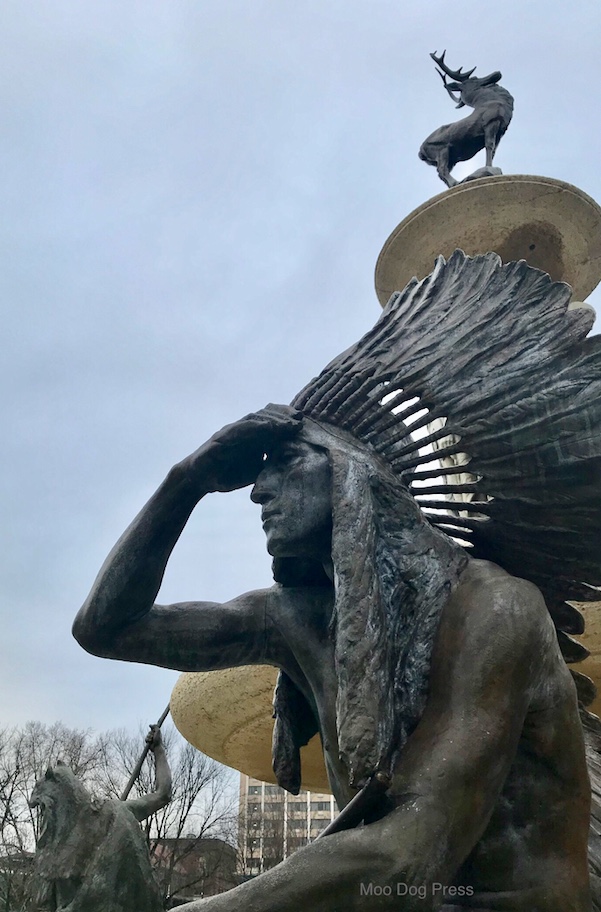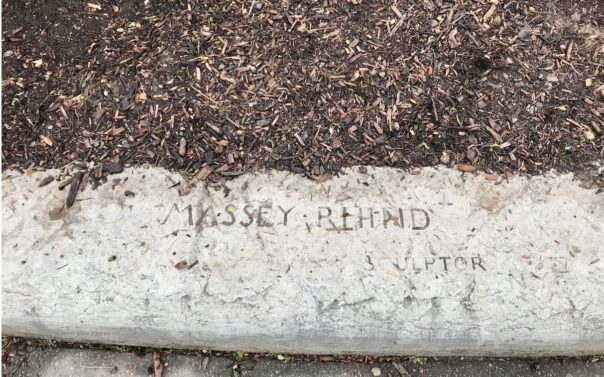Imagination Harnessed Will Take You Places: Skating Away, It’s A New Day
“One day you'll wake up, in the present day
A million generations removed from expectations
Of being who you really want to be
Skating away, skating away, skating away
On the thin ice of the new day
So as you push off from the shore
Won't you turn your head once more
And make your peace with everyone
For those who choose to stay
Will live just one more day
To do the things they should've done…”
Tomorrow is promised to no one. Every day ask: “What am I willing to leave undone, unseen, unsaid, unwritten?” Then get going. Your time is finite, so's mine. All forms of life, even the planet, are recycled endlessly. Time is our most valuable commodity.
Walk and really look around to notice things most others miss or may not be able to capture in words or images, film or digital forms. Poetry, music, or an idea for a business that simply calls to you — all take action to come into being.
Because starting, running, growing a business is a creative act. Making something where there was nothing before is an act familiar to artists, artisans, publishers, builders of every stripe. It takes guts and commitment. Like riding a bicycle or a horse, to acquire skills means scrapes and bumps, days of accomplishment and others of utter disappointment. Challenge mind, body, soul. Making something from nothing is a rewarding achievement. Any parent and/or teacher, gardener or chef worth his or her salt — there is joy and satisfaction from helping something or someone grow. Thoughts take form and step out into the world. Imagination harnessed, set goals and act upon them.
Visiting the Corning Fountain is now checked off from a life's bucket list. In winter, the water flow is turned off, but the artistry of these spectacular figures stands. A connection, found. Armsmear, once the home of Samuel and Elizabeth Colt (now private), is adjacent to the sloping land and scenic views of the Colt factory complex and Connecticut River. Samuel Colt's memorial and what is now Colt Park. Surprise. Both the Corning Fountain and Colt Memorial are the work of the same sculptor, Massey Rhind. (Another intriguing bit of history is that Elizabeth Colt had the memorial placed over where here family was once interred after her loved ones were moved to Cedar Hill Cemetery.)
“The monument [Corning Fountain] is made of marble and stone, 30 feet tall, with the figure of a stag (or “Hart” for Hartford) surrounded by Saukiog Indians, the city’s first inhabitants. Mr. Rhind was one of the most famous sculptors of his time. Locally, he created the Colt Memorial at the entrance of Colt Park for Mrs. Samuel Colt.” — Bushnell Park Foundation
Bushnell Park in Hartford in any season offers views, trees, pathways, sculpture, memorials, history. And ice skating.
“Skating away on the thin ice of a new day…” so sang Jethro Tull to the delight of skaters everywhere (see below for a linked interview with Ian Anderson). Music adds to the joy of being 100 percent alive, especially wonderful while gliding on ice. Here's an opportunity to learn or polish skills, or be inspired by the circling skaters of all abilities. Kudos to the iQuilt Partnership, organizers, businesses in Hartford that provide support to make this event happen each year.
The details: Winterfest Hartford, Bushnell Park, Hartford (near the pump house) through Jan. 20, free ice skating, free skate rentals. Open every day weather permitting, 11 a.m. to 8 p.m. No age restrictions, but those younger than 16 must be accompanied by an adult. Free skating lessons are offered on Saturdays (Jan. 11, 18), 10 to 11 a.m., weather permitting. Complete a Winterfest Learn to Skate form and bring it to the lesson. Helmets are not provided, but are recommended for small children.
Be sure to check out the reindeer (or is it really a hart/stag?) near the pump house overlooking the skating area. Created by makers at MakerspaceCT, which is located in the Historic G. Fox building at 960 Main St., downtown Hartford. Mission: “…to positively impact lives by enabling access, innovation, and education. Our vision is to use making as a vehicle to lift up individuals and communities. …Equipment, community, and education so that you can develop skills, make connections and launch ideas.” (Adding this as a must-visit place in 2020.)
The Bushnell Park Carousel is also open on Fridays, Saturdays and Sundays, 11 a.m. to 5 p.m. during Winterfest; $2 per ride per person. Street parking can be found on Elm, Trinity, and Jewell Streets. Parking is free in Hartford after 6 p.m. during the week and always free on Saturday and Sunday. If the memories have faded about just carousels, visit to listen and take a ride. Or two. The upbeat music is provided by a Wurlitzer band organ.
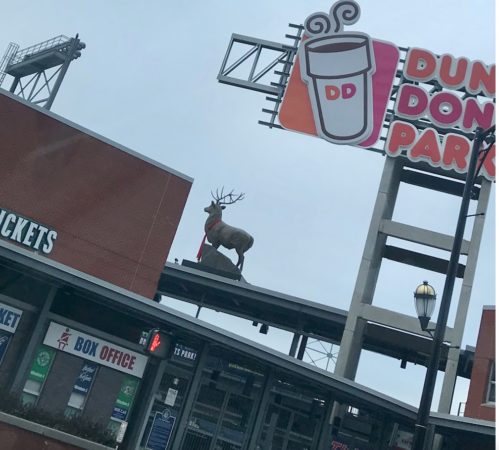
Another hart (or stag), this one with a red scarf, seen at the home of the Hartford Yard Goats, Dunkin Donut Park on the way to First Night.
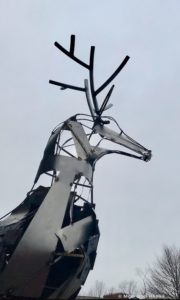
Beautiful work from makers at MakerSpaceCT; a reindeer or another hart/stag? Located near the skating rink in Bushnell Park, what is seen is in the eyes of the beholder.

Juxtaposition. A Tesla Supercharger just steps away from a sign that remembers Bill Savitt (P.O.M.G.), who knew the value of branding and valued his customers. Both seen on Asylum Street, Hartford.
Seen on Asylum Street, Tesla Superchargers steps away a historical marker for Savitt Jewelers, 1937 to 1987. Ahead of the rest for branding and catchphrases, customer service and his business, Bill Savitt is remembered.
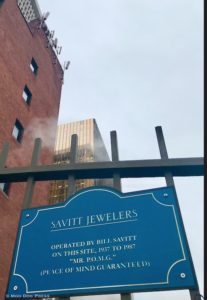
“Savitt Jewelers. Operated by Bill Savitt on this site, 1937 to 1987. “Mr. P.O.M.G.” (Peace of Mind Guaranteed).
Another place to visit to see the power of making things real is the exhibit Mr. Gilbert's Railroad ongoing through Jan. 19, 2020 at Eli Whitney Museum & Workshop, Hamden, Conn.
This hands-on exhibition of American Flyer Trains, classic toy trains produced by New Haven's A.C. Gilbert Company, is open Saturdays, 10 a.m. to 3 p.m.; Sundays, noon to 5 p.m. Admission is free. Wooden trains to construct on site and take home, $11.
“A.C. Gilbert purchased, redesigned and produced American Flyer trains relatively late in his career. It was also relatively late in the history of American railroads. Airports and highways were reshaping American geography. Gilbert’s trains recollected past power and glory of rail. Gilbert's trains recollected the power and glory of his life.”

A holiday train display is at Eli Whitney Museum and Workshop in Hamden, Connecticut. And yes, the locomotive emits smoke as it chugs along.
“East Rock Park is a park that was developed with naturalist landscaping, around and including the mountainous ridge named East Rock, located in the city of New Haven, Connecticut and the town of Hamden, Connecticut. The entire park, at 427 acres (173 ha) in size, is listed on the National Register of Historic Places and it includes six contributing buildings, one other contributing structure, six contributing objects and one contributing site….”

Whoo-whoooo. See the layout, then go watch a real train go by. Better yet, plan a train trip and enjoy the ride.
Train artist and historian Steve Cryan's work is on display at the Connecticut River Museum, Essex, where trains run daily Tuesday – Sunday through Feb. 23, 2020. A fully operational 26-foot train layout, “I-Spy” scavenger hunts, also a toddler-size viewing layout. For information visit ctrivermuseum.org.
“All men dream: but not equally. Those who dream by night in the dusty recesses of their minds wake in the day to find that it was vanity: but the dreamers of the day are dangerous men, for they may act their dreams with open eyes, to make it possible.” — T.E. Lawrence
For those interested, here is a link to a Rolling Stone interview (2018) with Ian Anderson (Jethro Tull), who summarizes his life in 10 songs, including “Skating Away (on the Thin Ice of A New Day)” — quite relevant in 2020.

